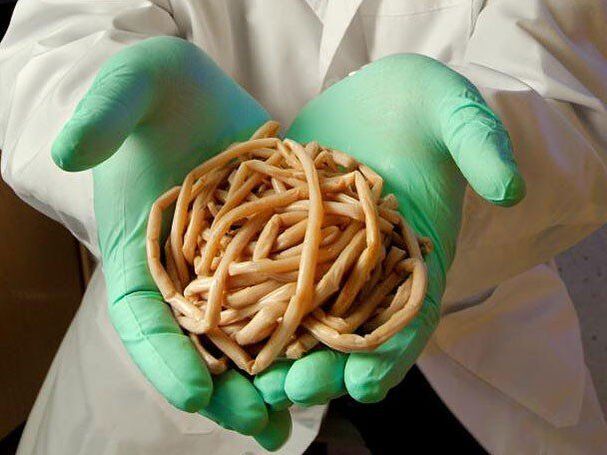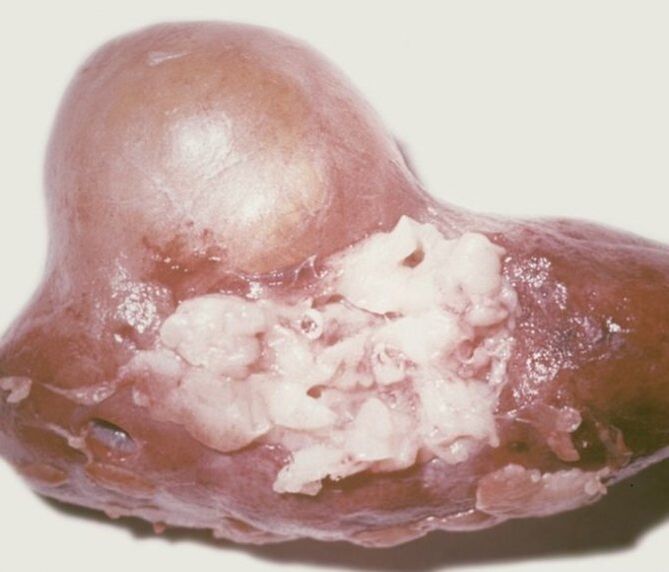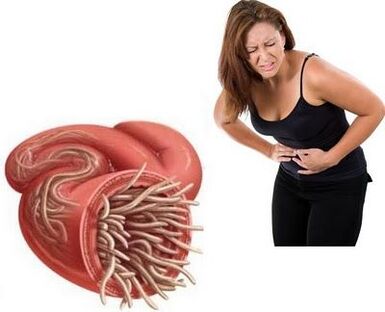Parasites - This is the name of one of the most common groups of infectious diseases.Today, around 300 parasites are known, which are a danger to humans, including deadly.On the territory of the European continent, these are only a few dozen parasites (medical name - Helminthias, Helminthic invasion).
Most of the relevant parasites for humans are common in countries with a tropical and subtropical climate, as well as a low level of socio-economic development and health culture.
What are the dangerous parasites

Parasites of the human body can affect almost all organ systems.The degree of damage depends on the type of helminthe, the duration of the disease, the initial state of health.The sooner the diagnosis of a specific Helminthic invasion is established, the more likely there is a chance to get rid of the parasite quickly.This is why it is important to diagnose the invasion condition with parasites in a timely manner and to carry out all stages of treatment.
Almost all the variants of helminthiasis, especially for a long time, cause significant damage to the human body.The invasion of Hlybonne is the reason for the delay in psycho-motor development in children of all ages, considerably reduces performance and life reserves in an adult.
Whatever the age of a person, the Helminthic invasion contributes to allergication, reduces the ability of the immune system to resist infectious and other diseases, moreover, the effectiveness of the ongoing vaccine prophylaxis is considerably reduced.
Cleaning the body of parasites in rare cases spontaneously occurs, in most cases, specific treatment is necessary for this according to a certain diagram.
What are parasites

Parasites (these are also worms or worms) are a large group of multicellular organizations arranged with complexes which may have long been in an active state in various conditions.An important characteristic is the ability to exist within another living organism (person or animal), which is called "invasion".
Currently, various types of parasites in the human body are known.The most common classification of parasites according to their external structure and the characteristics of the life cycle.
Given the biological characteristics, all parasites are divided into 3 major classes:
- Towards round (these are also nematodes), for example, Trichinella, Ankylostoma, Pin, Ascaris;
- Towards ribbon (these are also cestodes), for example, alveococcus, echinococcus, wide band, tapeen, pork and dwarf;
- Supers (they are also tremontodes), for example, Opistorch, Fasciol, Clonorch.
In addition, like many other diseases, parasitic diseases differ:
- by gravity;
- By main syndrome, that is to say which organ system is damaged to a greater extent;
- by the presence and nature of complications;
- By the possible results of the disease.
Characteristics of parasites
Development stage
Parasitic diseases are characterized by a number of differences associated with the characteristics of parasites and their life cycle.
The number of adults of parasites in the human body does not increase, provided that there is no new infection.For the implementation of the life cycle, most parasites require a change of habitat (animal body, soil, etc.).
For any parasitic, the development stages are typical.Throughout the life cycle, Helminthe passes a number of stages of development in constant evolution.As a rule, the parasitic egg is transformed into a larva and further into an adult individual.The reverse development does not occur, the egg cannot go immediately to the stage of an adult.
The parasite penetrates the human body at a stage of its life cycle and comes out in another.It is at the moment that the non-treatment of practical people of human parasitic diseases is associated.In other words, it is impossible to be infected with a majority of parasitic diseases in direct contact with an infected person.
Possible penetration paths in the human body
With many types of parasites, a person can meet anywhere - they are not visible to the naked eye.The following options are very likely:
- The oral path, that is to say with non-compliance with personal hygiene, the use of dirty or thermal unprocessed products;
- The percutaneous path, that is to say that larvae or adults of parasites penetrate into the human body by damage to the skin, when contacting water or soil, with the participation of sugar factory insects.
Most parasites affecting the human body live only in the adult stage, mainly in the digestive tract.These are the intestinal parasites if called (helminths).They are in turn divided into 2 groups in accordance with certain features.
The intestinal parasites of the first group enter the human body in the form of an egg.In the digestive tract, they are transformed into an adult individual.The movements of such parasites (Pinworms, a large ribbon, pork and Ténia Taureau) are only limited by different departments of the digestive map.
The representatives of the second group (their larvae or eggs) perform a significantly longer and complex migration according to various tissues and organs of the human body.It was only after that that an adult individual of the parasite has formed.It is clear that the symptoms of these parasitic diseases are much more diversified, because the migration process is associated with significant changes in the body.
The parasites, which at the stage of an adult or larvae are located outside the digestive tract are called tissues.If in the human body, a parasite only exists in the stage of the larvae, then a person for him is an ecological dead end, which Helmint cannot leave.
Characteristics of the life cycle of parasites
To find out how to get rid of parasites in the body, it is necessary to represent their life cycle in general terms.This knowledge also helps to prevent parasites from entering the human body.
In accordance with the characteristics of the life cycle, all parasites are divided into:
- Geo parasites;
- Contagious helmoses;
- Bio Helminythiasis.
To implement the life cycle of geo -paids (vlasov, a non -core), it is necessary that the eggs are a certain period of time in the soil.In the future, with direct contact with dirty soil, the use of insufficiently washed vegetables, through dirty hands, parasites enter the human body.
In contagiosted parasites (pinworms, dwarf tablls), all development stages only occur in the human body, without change in the environment.Only these types of parasitic diseases are transmitted directly from one person to another.It is also possible, in particular in childhood, cases of generation in reversion of auto, that is to say of oneself in the event of non-compliance with the rules and skills of hygiene.
The most complex life cycle in the so-appeal biogelmintosis.A prerequisite for the implementation of their life cycle is the presence of an intermediate host.A person can be an intermediate or final master.For example, with echinococcosis, a person is an intermediate host and dogs and cats are final.In the case of a tusherinchosis, on the contrary, the representatives of the cattle are intermediate hosts and a person is final.
Parasitic symptoms
The clinical signs of the parasites, on the one hand, are determined by the predominant damage to a particular organ, on the other hand, they have general characteristics which allow us to distinguish an acute and chronic stage from a parasitic disease.
The acute phase of a parasitic disease corresponds to the stage of migration of the development of Helminthes.It manifests itself by clinical signs such as allergic and general toxic reactions (ascariase, schistosomosis, fasciolesis, trichinellosis).
The immunological component has a significant weight in the development of the acute phase of parasitosis, forms a certain stereotype of the clinical picture and certain similarities with other immunological reactions of a non -infectious nature - medication, allergic dermatitis and others.
The hidden period with most of the parasitosis is several weeks, is reduced to 7 to 10 days with a massive version of the infection and lengthens with low intensity.
The main symptoms of parasitic diseases are as follows:
- Increase in body temperature - from very high subfebrile;
- Pain in muscles and joints, various durations and intensity;
- the formation of a rash on the entire surface of the skin, different in size and intensity, accompanied by itching skin;
- Significant edema of the skin and subcutaneous tissue, less often - mucous membranes;The most typical of trichinellosis, which gave the disease a popular "inflated" popular name;
- the development of pulmonary syndrome, namely night cough, astmotic states, pneumonia formation with a home migrating damage;
- the development of abdominal syndrome, which is characterized by moderate abdominal pain, liquid stools without impurity of mucus and blood;
- In serious cases, damage to the central nervous system and the heart are observed;
- A distinctive characteristic of helminthiasis is changes in peripheral blood: pronounced leukocytosis and significant eosinophilia (up to 30 to 40%).
In the treatment at the stadium of the acute phase of drugs from parasites of the human body, the most effective.
At the stage of the chronic phase of parasitic diseases, the harmful effect is determined by the type of adult parasite.The undesirable effect on the human body is associated:
- greater toxic and less allergic effects;
- Mechanical damage to tissues in the parasitization zone (for example, hepatic echinococcosis);
- the absorption of nutrients, a violation of metabolic processes, the development of anemia and cachexia;
- severe anemia;
- increased irritability and excitability of a person;
- It is possible to reach secondary infection and dysbiosis, the weight of other infectious and non -infectious diseases, as well as pregnancy.
The duration of the existence of individual parasites is different - from several days and weeks (cutters) to many years.After a parasitic disease, repair is possible because immunity is not formed.Consequently, a cleaning in time of the body of the parasites does not protect against a repeated episode of the disease.
Parasites treatment

Classic parasitosis pharmacotherapy in the present has had a significant success.The introduction into the clinical practice of the compounds of benzimidazole and imidazole has successfully treated many types of helminthias.
These drugs have a wide range of exposure, a small toxide with a brief treatment, for adults and children, are practical to use.The corresponding age of the dose of drugs should be observed.
How to clean the body of a specific parasite, which treatment diagram to choose and which medication is decided by the doctor.It is not recommended to prevent helminthiasis on the personal initiative, as the dependence on drugs develops, that is to say a decrease in their effect.
Cleaning of parasites
With parasitosis, treatment with folk remedies is no less popular than the means of traditional medicine.Supporters of natural tools for parasitic diseases focus on the safety and universality of such therapy.There is a lot of prescription for traditional medicine, which allows you to face parasites in the human body.The following options to eliminate parasites from the human body are the most famous:
- Coriander and pumpkin seeds as a prophylactic and therapeutic agent for parasites;
- alcohol dye on chanterelles combined with white mushrooms;
- a decoction of gables;
- Green nuts.
All the popular remedies for parasites must be made in accordance with the recipe and their own hands.Before choosing a particular recipe, it is important to make sure that a person has no allergy to the ingredients that are part of the medication.
How to protect yourself from parasites

It's both easy and difficult at the same time.Several simple rules will help minimize the risk of infection by any parasite:
- Wash your hands carefully;
- The good habit of using a set of individual dishes;
- Carefully treat the thermally meat and fish, with caution, use dried and salted fish and meat;
- Treat vegetables and fruits with boiling water (after washing in running water);
- Always wash your hands with soap after communicating with animals (even servants).
Parasite infection at any age is an unpleasant problem, but completely eliminates early treatment.






































